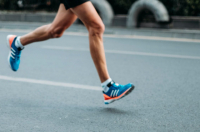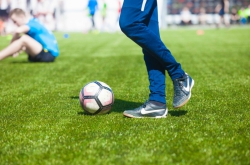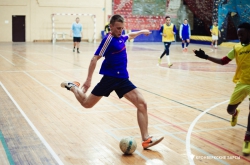Tell us about how ITMO Rowing club appeared.
Alexey Kopyt: When I was a first-year Bachelor's student, I decided to join the basketball team, but they didn’t even let me show my skills, as I never played professionally. I did rowing before, so I decided that ITMO lacked a rowing club. I asked my coaches for help, and they assisted me in negotiating with the rowing club on Krestovsky island so that they would allow students to train there for free. This year, we got a room in ITMO’s building on Lomonosova street, renovated it, and started training there as well.
Does your club focus on sports activities only?
Alexey Kopyt: Not at all. The club participates in all kinds of event that take place at the university; for example, for two years already we’ve been organizing contests on rowing machines as part of the Mister ITMO competition. We also organize events for the Student Rowing League and provide information support: teach broadcasters and find photographers for sports events. Fledgeling sports reporters comment races in live broadcasts in our community in VK and on the Student Rowing League’s webpage.
We also conduct competitions in winter; this year, we found partners and had a prize fund of 30,000 rubles as gifts. What is more, we help with developing services: we’ve developed a website for the Student Rowing League, and work on new sensors and training equipment. Every student can help our club in organizing events, providing information support, developing equipment, training, etc. Our club is a full-fledged organization that has many areas of focus. We aspire to create a European-style club that is not just a community of people with common interests, but is like a family that is ready to accept one’s ideas and offer support in their development.

In what way is rowing different from other kinds of sports?
Alexey Kopyt: Rowing is a cyclic sport like cross country skiing, cycling or running. Rowing utilizes 95% of one’s muscles; you use your back, arms and legs. Rowers sit on a seat fixed with wheels, so your legs constantly move, as well – something spectators rarely notice. Rowing requires lots of energy: the standard distance is two kilometers, which professional rowers cover in less than six minutes. In this short amount of time, they spend heaps of energy. Such workload does not just strengthen one’s core muscles, but also trains endurance, willpower, character. Rowing is also an ideal cardio, much better than running or cycling, and it’s less traumatizing, to boot.

Which competitions does ITMO rowing team participate in?
Alexey Kopyt: At first, we took part in Russian competitions organized by the Student Rowing League, as well as the St. Petersburg University Championship. This year, we got gold in several categories, having gotten ahead of the team of Lesgaft National State University of Physical Education, Sport and Health. Each year, we participate in the international Golden Blades Regatta in St. Petersburg, as well as the Grand Moscow Regatta. Our team also made it to the recent World Rowing Cup in Poland and student competitions in China, and we are currently preparing for a trip to Dresden.
Elizaveta Borsuk: There are not so many rowing competitions around St. Petersburg. The Student Rowing League organizes two types of races in Sestroretsk, with distances of 250 meters and six kilometers. In the city, we have the Autumn Marathon and the Spring Marathon, with a distance of five kilometers each; for most novices, it becomes their first racing experience.There are also competitions held in Toksovo and the Rowing Canal on Krestovsky island.

What about the recent competition in China?
Ivan Makagonov: The competition took place in the city of Changsha not far from Beijing, and brought together teams from the world’s best universities. Among the participants were rowing clubs from Cambridge, Oxford, Yale, University of Palermo, as well as Chinese and Japanese universities, 20 teams in total. At these kinds of events, you can see international-level rowing and understand in which direction to move.
We had three days of racing. On the first day, we got a new boat and went ahead of Cambridge’s team, and even bested Yale in the overall score. On the second day, we had training sessions and the semi-finals, and the finals took place on the third. Our line-up included eight rowers, a coxswain and our coach. The results we got were quite good: we were placed 9th in the overall standings, and were the first in our group in the semi-finals. This competition in China was on a whole different level than the ones we have in St. Petersburg. Also, it’s worth mentioning that our University’s rowing club has been around for only three years, whereas Cambridge, for instance, has a 187-year old rowing tradition.

How did you manage to enter the World Rowing Cup in Poland?
Elizaveta Borsuk: At the rowing club on Krestovsky island, we train with professional athletes , and some of our members have also made it to the professional level. Myself, for instance; I am now part of one of the professional teams organized by our coach. This year, we passed the selection for the World Rowing Under 23 Championship and went to Poland as part of the national team. This event is a lot more serious than the one in China, as it’s not some student competition but a World Cup that brings together teams from 55 countries. In result, we were placed 10th.
Ivan Makagonov: Rowing in Russia is not as developed as in many other countries. The Student Rowing League promotes this sport and sometimes gives a huge impulse. The Russian national team is not as successful as some others, and it is at major international events that we get to learn how other teams train, feel the atmosphere of an international competition. Above all other, rowing is about being a family of a sorts, about unity and team spirit. In the Western countries, rowing clubs are not just sports sections but communities of like-minded people who have their rules and traditions, and this is what we are aiming for, as well.

How does one enter the club?
Alexey Kopyt: Every year, we do a presentation during the Freshman Day and answer all the questions about the club. On the same day, we scout for potential candidates for our team: check their physical qualities and invite to come to the selection. In order to join us, one doesn’t have to possess any specific skills: most of our current members were once motivated novices or people who formerly practiced different kinds of sports.
Elizaveta Borsuk: Most sports sections in ITMO are selecting new members in the course of September. We tend to do it earlier, as we have to mind the weather conditions: in St. Petersburg, the water freezes very early. Last year, we had to close the season on October 31.

How are the training sessions organized?
Alexey Kopyt: We have two kinds of members: novices, who train at our place on Lomonosova street, and current team members who train on Krestovsky island with qualified coaches. Currently, those are Igor Zotov and Andrei Fomchenko who train teams for international-level competitions; for instance, the team of St. Petersburg State University trained by Igor Zotov won the European Rowing Championship in 2012.

Tell us more about the upcoming competition in Dresden.
Alexey Kopyt: We are going to Dresden in late August. There’ll be three participants from ITMO University; the team will also include students from St. Petersburg State University and First Pavlov State Medical University of St. Petersburg. Teams composed of members from several universities are quite common; for example, the national team that went to Poland was organized in such a way.
Elizaveta Borsuk: It is important to note that participation in both national and international events is almost free for the participants: most costs are covered by the receiving side or the Student Rowing League. All the sportsmen have to pay for is their tickets and visas. In order to go on such a trip as part of a team, you have to have a high level of training and experience, though novices can also participate; in this regard, things are looking especially good for coxswains.
What are the problems that ITMO Rowing club faces today?
Alexey Kopyt: One of the problems has to do with financing. As of now, we cover most of our expenses ourselves.The only exception is the costs of equipment that is covered by the Student Rowing League, and some help from the university. The equipment we need is quite expensive: the prices for boats range from 1,5 million rub, oars – from 50,000 rub, and rowing machines – from 120,000 per a single item. Also, we lack time for training qualified sportsmen, as you need several years worth of training in order to make it to the international level.





